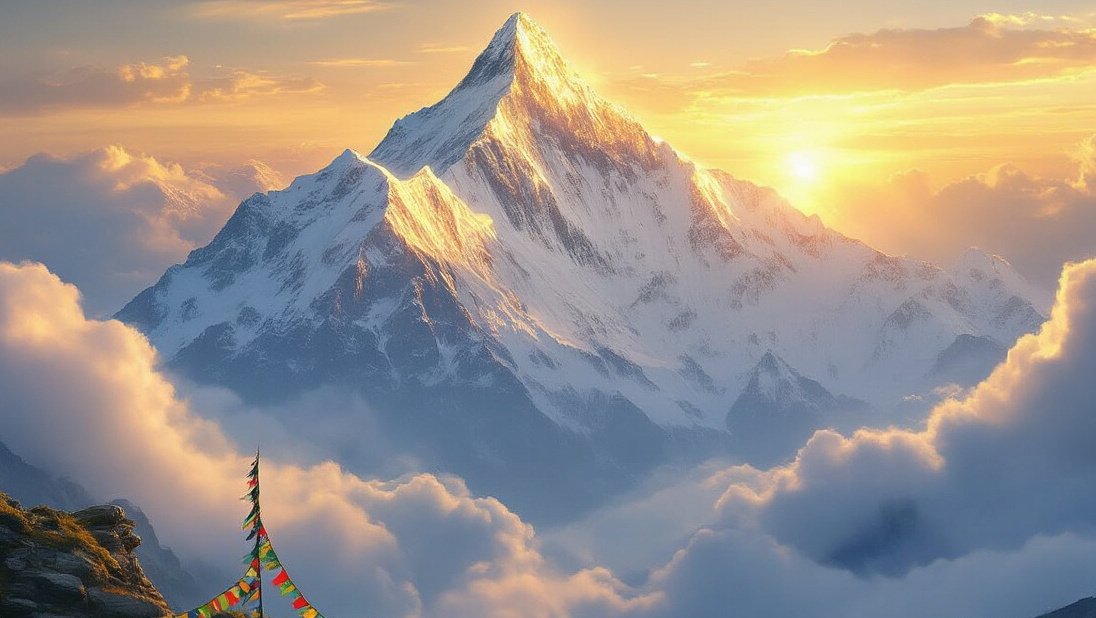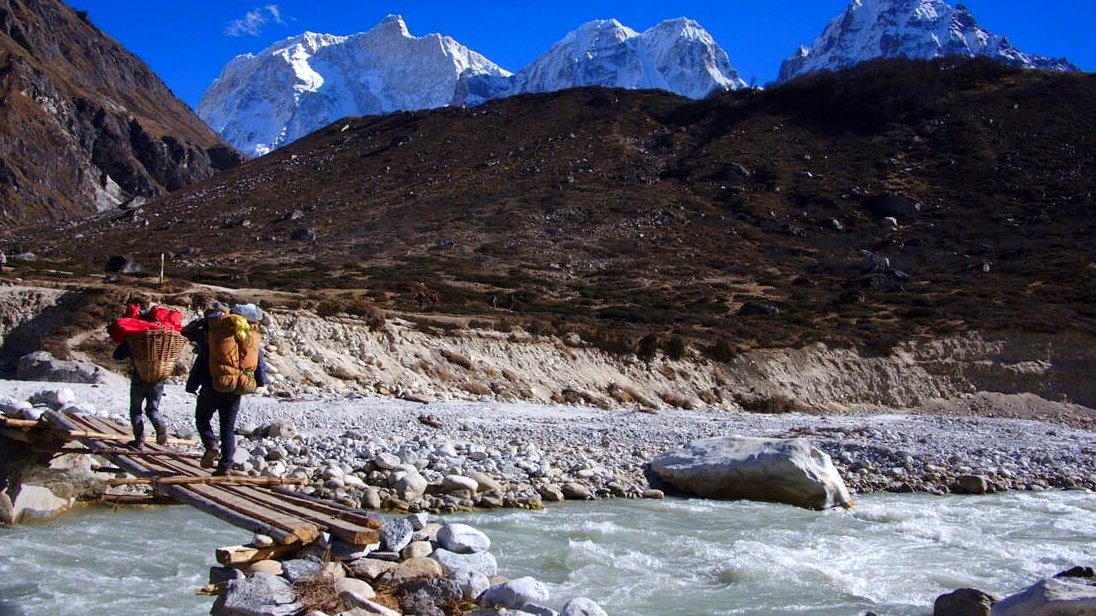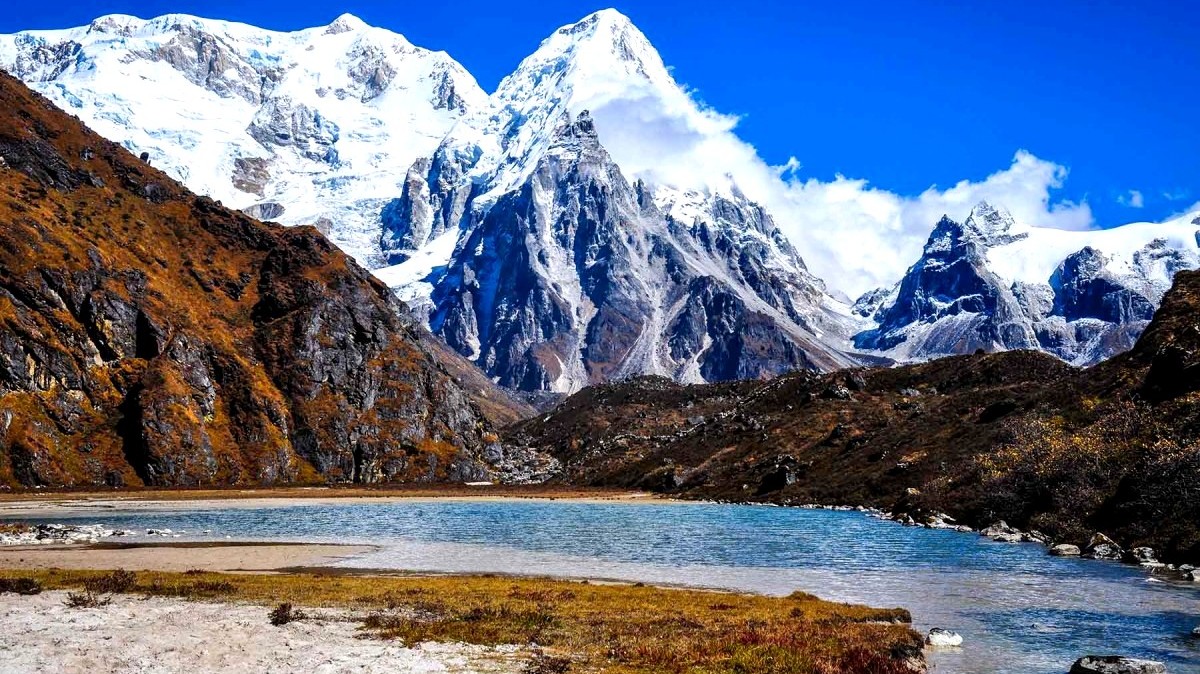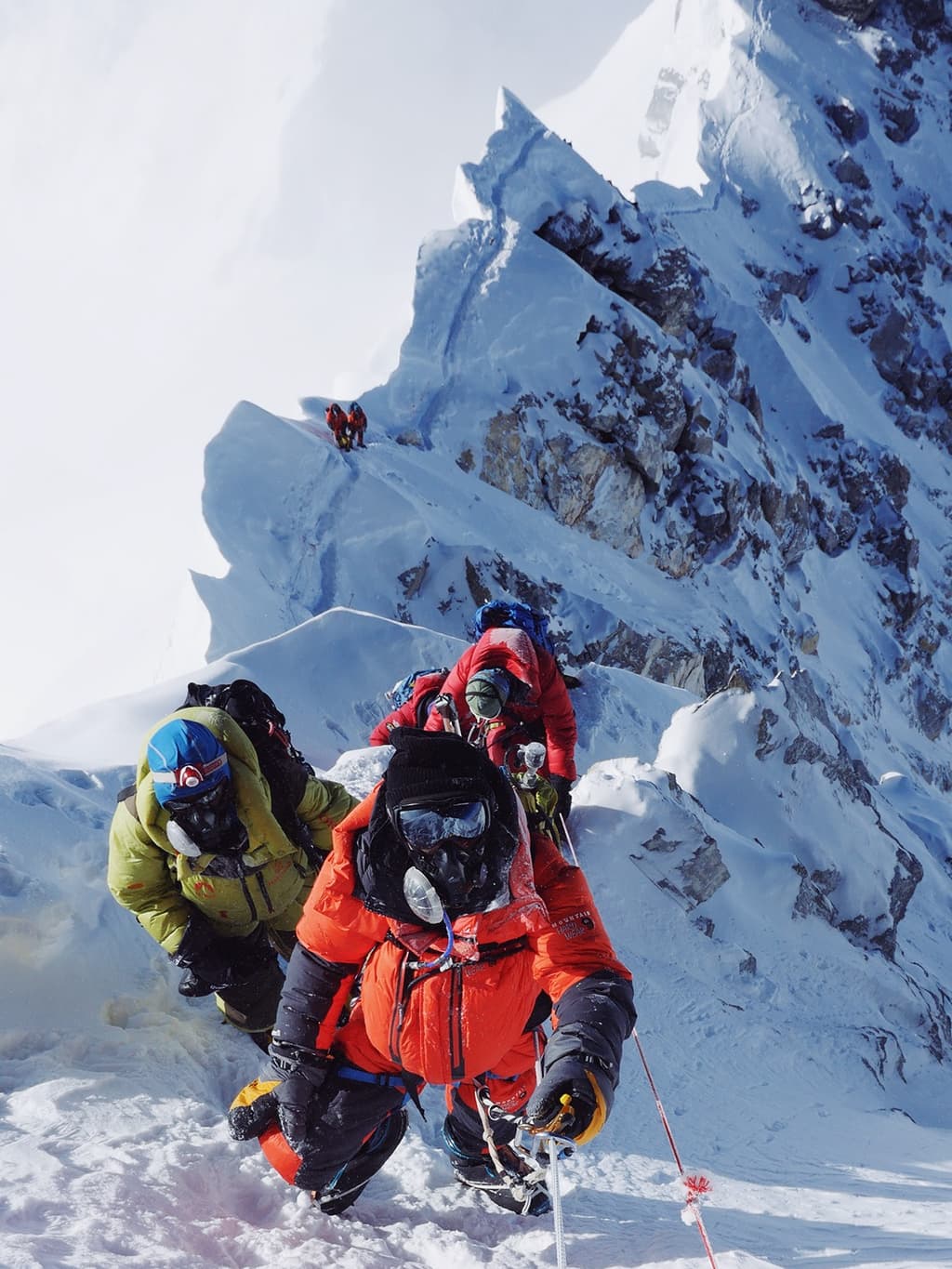Ever wondered what it feels like to stand near the world's third-highest peak, where the air is so thin your lungs burn with each breath? Not from some tourist viewpoint, but actually climbing the magnificent Kanchenjunga at 8,586 meters?
Most adventurers dream of conquering Everest, but those seeking the road less traveled find something more authentic on a Kanchenjunga Expedition. Here, you'll discover pristine wilderness that sees fewer than 100 climbers annually.
The mountain straddles Nepal and India like a sleeping giant, with five sacred peaks locals believe house deities. That's why the first successful summit team in 1955 stopped just short of the true peak, honoring local traditions.
But what makes this climb uniquely challenging isn't just the technical routes or unpredictable weather patterns...
Kanchenjunga: The Majestic Third-Highest Peak

Geographic location and prominence in the Himalayas
Kanchenjunga isn't just another mountain. It's a beast that stands 8,586 meters (28,169 ft) tall, making it the third highest peak on Earth. Straddling the border between Nepal and the Indian state of Sikkim, this mammoth mountain forms a natural boundary that's visible from hundreds of miles away.
The Kanchenjunga massif has five peaks, and locals call it the "Five Treasures of Snow" because each peak represents silver, gold, gems, grain, and holy books. On clear days, you can spot its distinctive silhouette from Darjeeling, where tourists wake up at dawn just to catch a glimpse of its snow-capped glory.
Historical significance and climbing history
The climbing story of Kanchenjunga is filled with tragedy, respect, and superstition. Unlike Everest, which was conquered in 1953, Kanchenjunga held out until 1955 when a British team finally reached its summit. But here's the thing - they stopped a few steps short of the actual peak out of respect for local beliefs that the summit is sacred.
Since then, only about 400 climbers have reached the top - compare that to Everest's thousands. The mountain has a frightening death rate of around 22%, making it one of the deadliest 8000ers.
Early exploration attempts in the 1800s and early 1900s were mostly mapping missions. The 1905 expedition led by Aleister Crowley (yes, the occultist) ended in disaster with four climbers lost.
Cultural importance to local communities
For the Limbu people of eastern Nepal and the Lepcha of Sikkim, Kanchenjunga isn't just a mountain - it's a deity. They believe the mountain harbors a valley of immortality called Beyul, a sacred refuge that opens only in times of danger.
The name "Kanchenjunga" itself comes from Tibetan words meaning "five treasures of the great snow." These treasures represent the mountain's five peaks, each believed to hold different forms of prosperity.
Local festivals often include rituals honoring the mountain. The most famous is the Pang Lhabsol festival in Sikkim, where masked dancers perform ancient ceremonies to pay homage to the mountain god.
Villagers won't point directly at the peak - it's considered disrespectful. Instead, they'll gesture with an open palm or nod their head in its direction.
Unique ecological features of the region
The slopes of Kanchenjunga host one of the most diverse ecosystems in the Himalayas. The Kanchenjunga Conservation Area protects over 2,000 plant species and rare animals like the snow leopard, Himalayan black bear, and red panda.
The mountain creates its own weather system. Its massive bulk forces moisture-laden air from the Bay of Bengal upward, creating distinct climate zones on different faces of the mountain.
You'll find tropical forests at the base, with dense rhododendron forests giving way to alpine meadows as you climb higher. Above 4,000 meters, the landscape transforms into a barren moonscape of rock and ice.
The region's isolated valleys have led to unique evolutionary adaptations in many species. Researchers are still discovering new plants and insects here that exist nowhere else on Earth.
Preparing for Your Kanchenjunga Expedition
Physical training requirements and fitness tips
Think Kanchenjunga is just another hike? Think again.
This beast demands serious physical preparation—at least 6-8 months before your expedition. You'll need cardio endurance that doesn't quit, leg strength that can handle days of uphill climbing, and core stability to support heavy packs on uneven terrain.
Here's what works:
-
Long-distance running (build up to 10+ miles)
-
Stair climbing with a loaded pack (start with 20lbs, work up to 40-50lbs)
-
High-intensity interval training 3x weekly
-
Strength training focusing on legs and core 2-3x weekly
The secret weapon? Altitude training. If you can't access high elevations, look into mask-restricted breathing equipment or altitude simulation classes.
Essential gear and equipment checklist
Missing gear on Kanchenjunga isn't just inconvenient—it can be deadly.
Technical Gear:
-
Crampons compatible with your boots
-
Ice axe (lightweight but durable)
-
Climbing harness with spare carabiners
-
Ascenders and descenders
-
Helmet rated for mountaineering
Clothing Layers:
-
Down suit rated to -40°F
-
Multiple insulating mid-layers
-
Moisture-wicking base layers (3+ sets)
-
Expedition-weight gloves plus liners
-
Insulated mountaineering boots
Personal Items:
-
Sleeping bag (rated to -30°F minimum)
-
Closed-cell foam pad plus inflatable mattress
-
Headlamp with extra batteries
-
Multi-tool knife
-
Water purification system
Safety Equipment:
-
Personal medical kit
-
Avalanche beacon
-
Emergency communication device
Rent the expensive stuff if budget's tight, but never skimp on quality.
Mental preparation strategies
The mountain will break you mentally before physically.
Successful climbers develop these psychological muscles:
-
Visualization techniques (mentally rehearse summit day in detail)
-
Meditation practice (helps manage oxygen-deprived anxiety)
-
Goal-setting in small, achievable chunks
-
Confidence in turning back when necessary
Create a personal mantra that keeps you going when every fiber of your being wants to quit. Practice using it during training when you hit walls.
The toughest mental challenge? Patience. You'll spend days—sometimes weeks—waiting out storms in your tent. Bring lightweight entertainment that doesn't drain batteries quickly.
Required permits and documentation
Paperwork kills dreams faster than altitude sickness.
You'll need:
-
Nepal mountaineering permit ($1,800 per person, spring season)
-
Kanchenjunga Conservation Area permit
-
TIMS card (Trekkers' Information Management System)
-
Valid passport with 6+ months validity
-
Travel insurance specifically covering high-altitude rescue (minimum $100,000 coverage)
-
Medical clearance from a physician
Apply at least 3 months before your expedition through a registered trekking agency in Nepal. DIY applications get rejected or severely delayed.
Ideal seasons for climbing Kanchenjunga
Timing is everything on this mountain.
Pre-monsoon (April-May):
The sweet spot. Stable weather windows, manageable temperatures at higher camps, and slightly less avalanche risk.
Post-monsoon (September-October):
Colder but often clearer skies. Snow conditions are typically more stable, but shorter days mean less climbing time.
Winter/Summer:
Death wishes. Don't even think about it unless you're among the elite few attempting new winter routes.
May typically offers the highest summit success rates, but comes with more crowded base camps. Early April climbers face deeper snow but fewer teams.
Our Exclusive Expedition Route

Detailed itinerary breakdown
Ever wondered what climbing the world's third-highest mountain actually looks like day by day? Here's our exclusive route that balances safety, acclimatization, and the best possible summit chances:
Days 1-2: Kathmandu (1,400m)
Arrival, gear check, and permit processing
Days 3-4: Taplejung & Suketar (2,420m)
Fly to Suketar, begin trek through beautiful rhododendron forests
Days 5-8: Trek to Khambachen (4,050m)
Passing through Chirwa, Sekathum, and Ghunsa villages
Days 9-11: Lhonak (4,780m)
Critical acclimatization period with day hikes
Days 12-14: Kanchenjunga Base Camp (5,100m)
Establish base camp and rest
Days 15-30: Rotation through camps
-
Camp 1 (5,700m): Technical climbing begins
-
Camp 2 (6,400m): Navigate challenging glacier terrain
-
Camp 3 (7,100m): Final preparations before summit push
-
Camp 4 (7,550m): Summit staging point
Days 31-35: Summit Window
Weather-dependent summit attempt (8,586m)
Days 36-44: Descent and Return
Carefully descend to base camp and trek back to Suketar
Base camp facilities and amenities
Our Kanchenjunga base camp isn't just a stopping point—it's your home for weeks. We've crafted it to be your sanctuary in this harsh environment.
The communication hub features satellite phones and internet connection, keeping you linked to loved ones and weather updates. Our dining dome becomes the heart of expedition life, with three hot meals daily prepared by our Sherpa chefs. Think fresh-baked bread, local specialties, and enough calories to fuel your climb.
You'll sleep in spacious personal tents with thick sleeping pads, while our heated shower tent and toilet facilities maintain hygiene even at 5,100m. Our medical tent includes oxygen systems, hyperbaric chambers, and first-aid equipment staffed by experienced high-altitude medical professionals.
A dedicated team manages everything, from solar power systems to waste disposal, allowing you to focus entirely on your climbing goals.
Key milestones and checkpoints
The journey to Kanchenjunga's summit breaks down into clear achievements that keep your motivation high through the toughest days:
Khambachen (4,050m)
First views of Kanchenjunga's massive north face. This marks your transition into the high alpine environment.
Base Camp Arrival (5,100m)
The culmination of your trek and the beginning of the real climbing challenge.
Camp 1 Rotation (5,700m)
Your first test on technical terrain, navigating through the challenging icefall.
Camp 2 Push (6,400m)
Breaking the psychological 6,000m barrier, where oxygen becomes noticeably thinner.
Camp 3 Acclimatization (7,100m)
Entering the "death zone" altitude range briefly, testing your body's adaptation.
Summit Day
From Camp 4, the final push to 8,586m requires crossing the notorious "Great Shelf" before reaching the summit plateau.
We celebrate each milestone with small traditions—prayer flag ceremonies at base camp, special meals after successful rotations, and personal summit flags to carry.
Acclimatization schedule and strategy
Kanchenjunga demands respect, and our acclimatization strategy has been refined over decades of high-altitude expedition experience.
Our "climb high, sleep low" approach follows this pattern:
-
Gradual trek in - Never gaining more than 300-500m sleeping altitude per day
-
Rest days - Strategic rest days at 3,000m, 4,000m, and 5,000m
-
Rotation cycles - After base camp establishment:
-
Cycle 1: Base Camp → Camp 1 → Return to Base Camp
-
Cycle 2: Base Camp → Camp 1 → Camp 2 → Return to Base Camp
-
Cycle 3: Base Camp → Camp 1 → Camp 2 → Touch Camp 3 → Return to Base Camp
-
Final Push: Base Camp through all camps to the summit
This methodical approach allows your body to produce more red blood cells, adapt to lower oxygen levels, and reduce your risk of altitude sickness.
We monitor your progress using daily pulse oximeter readings and regular check-ins with our expedition doctor. Our oxygen strategy includes emergency oxygen at all camps and supplemental oxygen for summit day, customized to your acclimatization performance.
The Everest Sherpa Expeditions Advantage
Our experienced Sherpa team profiles
When you're scaling the world's third-highest peak, who's by your side matters more than anything. Our Sherpa team isn't just experienced—they're legendary.
Each Sherpa on our team has a minimum of 15 years of high-altitude climbing experience. Most grew up in the shadow of the Himalayas and started carrying loads at 16. By the time they join our team, they've already accumulated skills most Western guides will never develop.
What makes our team special isn't just technical skill—it's their hospitality. They'll remember how you take your tea and notice when you're pushing too hard before you do.
Safety protocols and emergency procedures
Nobody plans to use emergency procedures, but on Kanchenjunga, preparation is everything.
Our safety system works on three levels:
-
Daily health checks (oxygen saturation, pulse, symptoms)
-
Hourly radio check-ins above Camp 3
-
Satellite tracking of all team members
We don't just have oxygen—we have triple redundancy systems. Three different communication devices. Multiple evacuation routes are mapped for each section of the mountain.
The difference? When a sudden storm hit last season, every single one of our climbers was safely at base camp within hours, while other teams were scattered across the mountain.
Exclusive support services
The little things make all the difference at 8,000 meters.
While other companies pack up when the climbing starts, we're just getting warmed up. Our exclusive services include:
-
Personal sherpa ratio of 1:1 above Camp 2
-
Private heated dining tent with charging stations
-
Daily weather forecasts from three separate meteorological services
-
Hot showers available up to Base Camp
-
Custom meal plans based on your metabolic testing
We even bring a portable hyperbaric chamber—technology most expeditions only dream of having.
Success rate and expedition history
Numbers don't lie. Our 78% summit success rate speaks volumes on a mountain with an industry average of 45%.
Since our first Kanchenjunga expedition in 2007, we've led 23 successful trips with 182 climbers reaching the summit. More importantly, we've maintained a perfect safety record—every climber who's joined us has returned home.
What's our secret? We turn people away. Not everyone who applies joins our teams. We carefully assess each climber's experience, training history, and psychological readiness. This selective approach means stronger teams, better group dynamics, and ultimately, more summits.
When other companies are selling spots to anyone with a checkbook, we're building teams that actually have a shot at standing on top of the world's third-highest peak.
Life on Kanchenjunga
Daily routines during the expedition
Life on Kanchenjunga isn't exactly a walk in the park. Your day starts around 5 AM when the cold is so brutal you can feel it in your bones. But we've got a system.
Morning rituals include melting snow for water (yes, everything freezes overnight), quick hygiene with wet wipes (showers? what showers?), and a hearty breakfast to fuel the day ahead.
By 7 AM, if it's a climbing day, we're already gearing up—checking oxygen, radio comms, and safety equipment. On acclimatization days, we might sleep in until the luxurious hour of 6 AM.
Afternoons at base camp involve equipment maintenance, route planning, or short walks to keep our bodies active. The golden rule is: never waste good weather. When skies are clear, we move. When storms hit, we hunker down.
Evenings are a social time. Climbers gather in the mess tent, swap stories, play cards, or read. By 8 PM, most of us are in sleeping bags—the body needs rest at these altitudes.
Meals and nutrition at altitude
Eating at 6,000+ meters isn't about pleasure—it's survival. Your body burns calories like crazy, even when you're just breathing.
Our typical meal plan looks like this:
|
Meal |
What We Eat |
Why It Matters |
|
Breakfast |
Oatmeal, eggs, pancakes, tea |
Slow-release carbs for sustained energy |
|
Climbing snacks |
Chocolate, nuts, jerky, energy gels |
Quick calories, easy to eat while moving |
|
Dinner |
Rice, pasta, dal, occasional meat |
Protein for recovery, carbs to refuel |
Most climbers lose 10-15 pounds on Kanchenjunga despite eating 4,000+ calories daily. Your body just works harder up here.
Our kitchen team works magic with limited resources. Trust me, hot soup after a freezing day feels like a five-star meal.
The biggest challenge? Making yourself eat when you have zero appetite due to altitude. We call it "forcing function eating"—you eat by the clock, not by hunger.
Communication with home base
Gone are the days when climbing meant complete isolation. We now use satellite phones, InReach devices, and occasionally even Wi-Fi at base camp.
Daily check-ins with our Kathmandu office are non-negotiable. We report weather conditions, climber health, and progress. This information gets relayed to families and posted on our expedition updates.
Each team member gets satellite phone time weekly to call home. These five-minute connections with loved ones boost morale more than any motivational speech ever could.
For emergencies, we carry multiple redundant systems—satellite phones, radios, and GPS beacons. When someone's safety is on the line, communication becomes our lifeline.
Weather challenges and how we manage them

Kanchenjunga creates its own weather. I've seen blue skies turn into whiteout blizzards in 20 minutes flat.
We rely on professional forecasting services that send daily updates via satellite. But local knowledge trumps technology—our Sherpa guides can read cloud patterns better than any computer model.
High winds are our biggest enemy—not cold, not snow. Winds above 40 mph make climbing impossible and dangerous. We've spent up to five days straight in tents waiting out storms, playing endless card games, and rationing food.
Our weather strategy is simple: patience and flexibility. Summit windows might appear with little notice, so we stay ready. Sometimes that means rushing up when conditions improve; other times it means a tactical retreat to lower camps.
The mountain's weather demands respect. Push against it, and it pushes back harder. Work with it, and you might just reach the top.
Client Success Stories
Testimonials from previous expeditioners
The stories from our Kanchenjunga climbers say more than we ever could. Take Sarah from Australia who told us: "After two failed attempts with other companies, Everest Sherpa Expeditions finally got me to the summit. Their attention to safety while pushing me just enough made all the difference."
Or Dave, who climbed with us last spring: "The Sherpas aren't just guides—they became family. When I got altitude sickness at Camp 3, they knew exactly what to do without panicking. That's experience you can't fake."
We're especially proud of what Maria shared: "As a solo female climber, I researched dozens of companies. These guys never once made me feel like I didn't belong on that mountain. They respected my skills while providing the support I needed."
Even seasoned climber Raj was impressed: "I've summited five 8000ers, and this team's logistics were flawless. The weather windows they picked were perfect—they really know this mountain inside out."
Photo gallery of successful summits
Nothing captures the pure joy of standing on Kanchenjunga like the faces of our climbers. In our gallery, you'll find shots that tell the whole story:
-
The sunrise summit push—headlamps creating a zigzag light trail up the mountain
-
The prayer flag moment—when climbers first reach the top and honor local traditions
-
The exhausted but triumphant faces at the summit
-
The celebration hugs at Base Camp after safe return
-
The comparing of frostbite-free fingers (a point of pride for our safety-focused team!)
We update our gallery after each expedition season, so you can see the actual conditions and routes from recent climbs.
Challenges overcome by our clients
Kanchenjunga isn't just physically brutal—it's a mental game too.
Jenny from Canada hit the wall at 7,400m: "I was ready to turn around. My fingers were numb, and I couldn't feel my face. My guide Mingma didn't push or pull me—he just shared a thermos of ginger tea and told me about his first summit. Somehow that 15-minute break reset everything, and I found new energy."
Technical sections trip up even experienced climbers. Mike, an ice climbing instructor from Colorado, struggled with the final ridge: "There's a traverse that requires perfect balance when you're operating on basically no oxygen. My brain was screaming to go back, but our lead Sherpa talked me through each placement. That's when you know you've got the right team."
Weather throws curveballs, too. Last year's team waited five days at Camp 4 for a window that never came—until our meteorologist spotted a 6-hour opening that other teams missed. All seven clients submitted safely.
Responsible Mountaineering Practices
Our environmental conservation efforts
Mountain climbing isn't just about conquering peaks—it's about preserving them for future generations. At Everest Sherpa Expeditions, we don't just talk about leaving no trace; we live it every day on Kanchenjunga.
Our teams carry specialized waste collection systems that ensure absolutely nothing gets left behind. Not a wrapper, not a broken carabiner, not even human waste. We've removed over 500kg of historical expedition debris from the mountain in the past two years alone.
We limit our group sizes to minimize our footprint. Smaller teams mean less impact on fragile alpine environments and more personal attention to ensure everyone follows our strict environmental protocols.
Respecting local customs and traditions
The Kanchenjunga region isn't just a playground for climbers—it's home to communities with centuries-old traditions.
Before every expedition, we brief our clients on local customs. That prayer flag isn't just colorful decoration—it's sacred. That oddly shaped rock? Probably holds deep significance to locals.
We participate in traditional blessing ceremonies before ascending, not as tourists seeking photo ops, but as respectful visitors acknowledging we climb by permission of both nature and local culture.
Our Sherpa guides serve as cultural ambassadors, sharing stories and traditions that make the mountain more than just a physical challenge.
Sustainable expedition management
Gone are the days of wasteful expeditions. We've redesigned our entire operation around sustainability:
-
Solar power generators at base camp
-
Reusable oxygen systems where possible
-
Local food sourcing to reduce transport emissions
-
Equipment repair stations to extend gear lifespan
We track our carbon footprint for each expedition and offset it through verified local reforestation projects.
Community support initiatives
The best adventures give back. We invest 7% of expedition fees directly into community projects:
-
Funded three local schools with climbing safety training
-
Established a medical clinic serving four remote villages
-
Created a guide training program for local youth
-
Support women's weaving cooperative providing sustainable income
When disaster strikes—like the 2015 earthquake—we're not just visitors; we're partners in recovery. Our emergency fund activated within hours, delivering essential supplies before larger aid organizations arrived.
Mountain communities aren't tourist attractions; they're our colleagues, friends, and the true guardians of Kanchenjunga.
Conquering Kanchenjunga is a remarkable achievement that requires extensive preparation, expert guidance, and unwavering determination. Through our carefully crafted expedition route, the dedicated support of our experienced Sherpa team, and our commitment to responsible mountaineering practices, Everest Sherpa Expeditions provides you with the optimal environment to succeed on this majestic third-highest peak. From the thorough preparation phase to the life-changing moments spent on the mountain, every aspect of your journey is meticulously planned.
We invite you to join the ranks of our successful climbers who have stood atop this magnificent Himalayan giant. Whether you're an experienced mountaineer seeking your next challenge or embarking on your first 8000-meter expedition, our team is ready to guide you safely through this incredible adventure. Contact Everest Sherpa Expeditions today to begin your Kanchenjunga journey – where your mountaineering dreams meet our expertise to create memories that will last a lifetime.
If you need any further information, please contact us by email: [email protected], Phone: +977- 980 195 6248 (WhatsApp).


